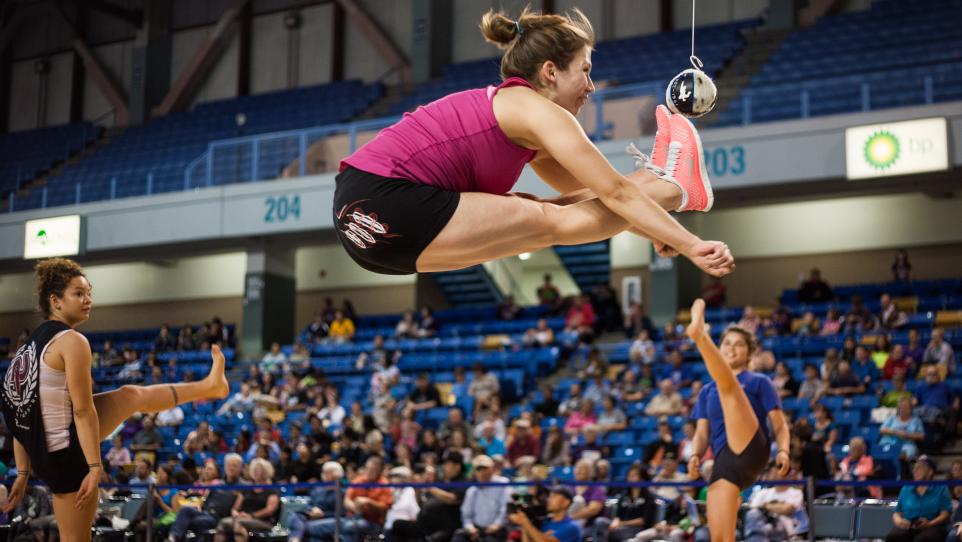
Fairbanks' golden heart beats a little faster when the World Eskimo-Indian Olympics (WEIO) are in town. For Alaska Natives, attributes of physical fitness—strength, agility and endurance—are life skills that have been passed from generation to generation for thousands of years. Now, every July in Fairbanks, we can see this living culture during WEIO. The energy-filled games of the far north are simply amazing. The Alaskan high kick, knuckle hop and the four-man carry are just three of the many athletic events that boggle the mind. Imagine hopping on bare knuckles across an unforgiving floor or flying eight feet into the air to kick a seal skin ball!

Fairbanks hosts WEIO, drawing athletes and dancers from around the state, the United States and Canada, as well as visitors, fans and media from around the globe. The 59th WEIO Games take place July 17-20, 2019 at the Carlson Center.
WEIO was created in 1961 in response to the rapidly spreading impact of western culture into rural areas. Two bush pilots, along with village elders and athletes, helped organize the first Olympics, which included a blanket toss, a seal-skinning contest and a Miss Eskimo Olympics Queen contest. The event has since grown to more than 20 games, with an ever-increasing number of athletes.

Besides being a test of strength and endurance, WEIO is also a time to celebrate Alaska Native culture. Parkas, moose hide dresses and vests, mukluks and moccasins are worn in competitive parka and Indian dress contests. It is also a time to dance and tell stories through songs and motion. Traditional dancers perform throughout the four-day Olympics.
Visitors to WEIO can browse through booths of authentic Alaska Native arts and crafts, and meet the people who carved, sewed, wove or beaded the items. WEIO affords visitors the rare chance to experience a culture alongside those who live within it. Daytime events are free to the public and more information including the full schedule is available at www.weio.org.
If you can’t be in town for WEIO, you can explore Alaska Native culture during other times of the year at many places throughout Fairbanks.

The Morris Thompson Cultural and Visitors Center showcases Alaska Native culture in exhibitions, programs and events. In addition to the Center’s exhibits of authentic Alaska Native art and historic artifacts, the Tanana Chiefs Conference Cultural Programs holds workshops with expert Alaska Native instructors, making items like beaded earrings, beaded gloves with fur, beaver fur hats and moose hide baby booties. From June through August, enjoy the Cultural Connections Show: a live performance featuring Alaska Native youth sharing dances, music and stories about their culture.

The University of Alaska Museum of the North is a premier visitor attraction and the only research and teaching museum in Alaska. The Museum is also the official state repository for artifacts and specimens collected on public lands in Alaska and it is a leader in northern natural and cultural history research. Highlights include a 2,000-year spectrum of Alaska art in the Rose Berry Alaska Art Gallery featuring ancient ivory carvings, gut parkas, contemporary paintings and sculptures all made by Alaska Native artists.
Discover additional Alaska Native cultural events and attractions on our events and things to do pages. For example, find authentic Alaska Native at fine art galleries and the UA Museum of the North Store. The Fairbanks Community Museum includes historic information of influential Alaska Natives of the 20th century, such as famous dog musher, George Attla. And a ride on the Riverboat Discovery includes a unique walking tour of a replica Athabascan Native village where young people share how their ancestors skillfully survived for over 10,000 years and how they adapted to village life and Western culture in the past century.
Each generation of Alaska Natives does its part to keep these cultural traditions alive. Whether they are dancing, drumming, participating in sporting activities or creating arts and crafts, all are on display in authentic Alaska Native events, exhibits and galleries that are accessible throughout the year. It is an enduring and very real link to the past, as well as a bridge to the future.








